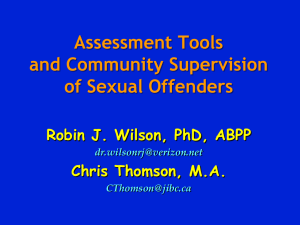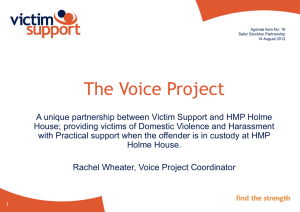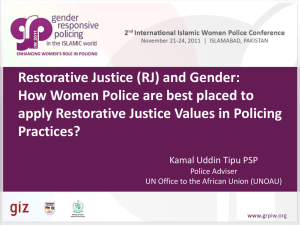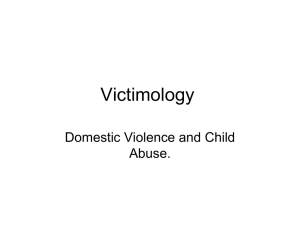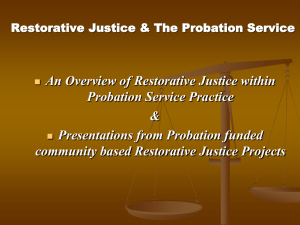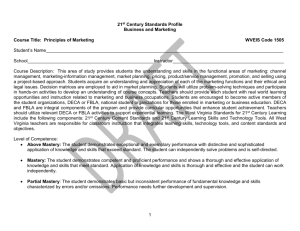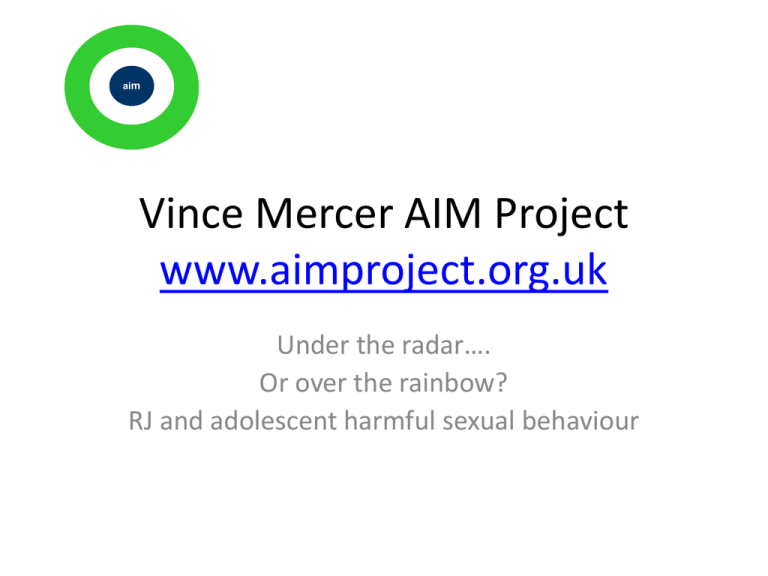
aim
Vince Mercer AIM Project
www.aimproject.org.uk
Under the radar….
Or over the rainbow?
RJ and adolescent harmful sexual behaviour
The title reflects….
Under the radar…..
Over the rainbow….
• Quiet and low key/low volume
work
• Less emphasis upon traditional
research methodology and
more on valuable practice
insight/knowledge
• Struggles with gaining funding
• Govt Statutory agencies
avoiding contentious/complex
cases/issues
• Confident about the
applicability of the approach
if…
• Good quality practice
standards and effective
assessment/ structured and
accountable decision making
• Growing demand from victims
and growing powerful
accounts of victims who have
experienced good RJ in a HSB
context
What I hope to cover….
• Some data on
prevalence and nature
of child/adolescent HSB
• Profile of victims
• Some consideration of
victim impact
• International RA to HSB
• The experience of
England and Wales
• Research concerns
• Practice standards
Prevalence
• Home Office statistics: 30-35% of all sexual assaults are
committed by young people under 18 years
• 10% of all sexual assaults are committed by children/ young
people (Joint Thematic Review Feb 2013)
• Only considers those young people who have gone down a
criminal justice route
• Approx 6% of a YOT caseload will be HSB (AIM survey 4/6 % of
Referral Orders for HSB)
CJJI Report ‘ Examining multi agency responses to children and
YP who sexually offend’ Feb 2013
• 24 cases all through CJS; Sexual assault most
common offence type
• 7 had pre conv. (only 1 forHSB)
• 2 had prev victimisation history
• 7 low IQ/SEN
• All had ‘complex needs’
• Only 1 sexual recidvism
CJJI contd ; Sentence type
•
•
•
•
•
4YOI/DTO
11 Comm Supervision
7 RO
1 FW
1 Not known
Relational context
• In cases of youth HSB
over 96% of offender
have some form of
relationship with victim
• In 40/50 % cases
interfamilial (Ryan)
• Simons Hackett’s research
on family responses to yp
displaying HSB 27% were
wholly interfamilial and a
further 27% were both
inter and extrafamilial
(2012)
Greater Manchester Youth Justice
Trust (GMYJT) data 2007
• In 107 case of male offender; in 55 cases
female victims (72%) in 19 cases male victims,
4 cases of both genders,
• In 2 cases of female offender 1 was a male
victim, 1 was female
GMYJT research
•
•
•
•
75 adolescent offenders, 109 victims
48 cases 1 single victim, 19 cases 2 victims
6 cases had 3+ victims.
In 2 cases no identifiable victim (new media/
indecent image cases; anecdotally this is
increasing)
GMYJT data
• In 79% of cases the offender/victim had some
form of relationship
• Of these 31% were interfamilial
• 19% of cases there was no relationship
whatsoever
GMYJT data; Age of victims
• In terms of age; child abusers were defined as
a victim4 yrs or more younger than
themselves
• 43% of offenders fell into this group, 43%
were peer abusers, 4% were adult victims,
(rest age unknown)
Types of offences
•
•
•
•
•
GMYJT research indicated;
Sexual assault (non penetrative) 67%
Rape 4.5%
Att rape 1%
Others described as ‘gross indecency, USI,
Indecent exposure, possession and
distribution of indecent imagery,
GMYJT data
• Most offences were non penetrative
• Over 69% single incidents taking place on a
single day
• Contrast with the presumed adult HSB notion
of multiple abuse over sustained period of
time
Comparisons with Australian data
• Bahours, 2006, South Australian data on 55 convicted adolescent
offenders.
• Remarkable similar
• Most victims female
• Most offenders male
• Most victims same age or younger than offender
• High congruence of relationship
• Sexual assault (non penetrative) most common offence
Brief observations on the victim
impact of adolescent SHB
No standard model of impact….
• ‘ ….it must be emphasized that people’s
reactions to being victimised are individual
and unpredictable. While there are some
discernable patterns, it can never be assumed
that a particular offence with have predictable
consequences for the victim’
• Prof Brian Williams 1999
What does the research say?
• Lack of reference to
sexual offending in
victimology
• Cross-over with
welfare/child abuse
• Few studies of the
impact of
child/adolescent- on
child abuse
Impact on Victims of HSB….
• 1/3 Have some impact that can be addressed and
supported by family members
• 1/3 are asymptomatic and show no sign of harm
• 1/3 require detailed specialist professional support
(drawn from presentation at NOTA Lancaster Conf by Lucy Berliner).
• Danger of extrapolating from narrow band of victim
impact studies that focus upon rape or adult on
Child Sexual Abuse
Link between CSA and later psychopathology
• There is considerable evidence of the impact of CSA on
psychological and physical health.
• However, some children have been found to
demonstrate considerable resilience in the face of such
adversity.
– ‘A significant number demonstrate no long term adverse effects’
Drawn from Dr Nadia Wagner, University of Bedford
• It appears that it is the disclosure experience rather than
the CSA per se, which accounts for the apparent link
(Waller & Ruddock, 1993; Everill & Waller, 1994)
• Specifically, reactions from recipients of the disclosure
that fuel a sense of self-blame or shame.
Influences on the level of harm….
• Protective factors
–
–
–
–
Having one supportive caregiver
Having positive adult role models
Individual/ collective factors of resilience
Opportunity to appropriately place responsibility and
articulate the reality of impact/state needs
• Risk factors
–
–
–
–
–
–
–
Early onset of abuse
Multiple perpetrators
The severity and duration of the abuse
Ongoing exposure to risk
Additional vulnerabilities
A negative response to disclosure/ victim disbelief/blaming
Adversarial Criminal Justice response
Resilience characteristics and Recovery
•
•
•
•
Being able to share problems with others
Being able to put your experience into a broader perspective
Using your experience to gain insight and awareness
Being able to find acceptable answers to why questions or, in some cases,
to stop asking the questions, because there are no answers
• Not feeling personally responsible for what happened and being able to
locate blame appropriately
• Being able to place reactions where they belong- that is, in the incident
that caused them, rather than internalise them
Adapted from Dr. D Meichenbaum
International Practice RJ/HSB
• South Australia has most widespread use of RJ
for Youth HSB. (Restorative Conferencing)
• Belgium has both limited Mediation and FGC
case experience
• Some experience of Mediation in Denmark on
Sexual Violence (Karin Sten Madsen)
• Project Restore adult based work in NZ
• ‘Victim Clarification’ model in some US states
UK and ROI
• NI Youth Conferencing Service
• Individual Case work in adult/ youth arena
from Probation Service and YOT’s
• ROI ‘One in Four’ faith based abuse
• AIM Project adolescent HSB using mediation
and FGC, Practice Guidance and RJ HSB
Assessment framework
Primary drivers for RJ in HSB cases
(AIM experience)
• Relational context of offence, negotiating a safer future
• Accounting for wider impact upon family, community
• Method to articulate the family impact and engage
with family as partners
• Shame acknowledgement, offender, victim and family
• To enable dialogue, work with strengths and integrate
into therapeutic work with victim, offender and family
• Failure of conventional CJS responses to deliver the
above
Reasons why RJ in HSB context has
been under the radar…
In RJ terms….
• Implementation of RJ in Youth
Justice following Crime and
Disorder Act
• Focus upon low hanging
fruit/easy outcome high
volume/low skill/reparative
activity
• Lack of commitment from YJB
• Poor trng for Restorative
practitioners in sensitive and
complex cases
• Lack of multi methodology for
RA
Fears….
• Anxiety around impacts on
victims of HSB; lack of direct
victim contact/engagement
• Adult offender models
stressing high
impact/deficits/ high risks
of offenders and need for
strong professional controls
• Poor networking/support to
Restorative practitioners
Research challenges for RJ in HSB
• Feb 2013 Heather Strang in conf ‘RJ Evidence; what do we
know/ where are the gaps?’ noted that although we know a
great deal about RJ, its application and effectiveness in a
general sense, we know very little about RJ for specific
complex offences such as gendered violence;
• Moreover for low volume/complex cases such as HSB the
gold standard of RCT may not be applicable/deliverable when
evaluating RJ with sensitive populations ; she states ‘Some
preliminary data on effectiveness may be obtainable by
methods less rigorous than RCT - but how useful? how
reliable’
Research 2
• At the same conf Joanna Shapland also
acknowledged that we know almost nothing
about the use of RJ conferencing for either DV
or HSB
• There is some limited data on the potential for
RJ to impact upon reported rates of PTSD with
regard to serious offences (Dr CM Angel; 2006;
RJC) but this is not specific to HSB
Research 3
• EU DAPHNE Project on RJ and Sexual Violence
due to report in Nov 2014. Found it difficult to
locate sufficient volume of practice to answer
traditional research questions/approach
• AIM’s case load closed last year and we have
been primarily interested in generating practice
knowledge and guidance as well as operational
tools such as the RJ/HSB Assessment Framework
and the Sensitive and Complex Case RJ
Assessment Framework
Reasons we might hope for a little
more ‘over the rainbow…’
•
•
•
•
•
•
Shift in YJB focus (Development Fund)
towards Sensitive and Complex cases
Increased access of victims to RJ (Victims
Code of Practice)
RJ commissioning via PCC’s
Establishment of Good Practice Standards
and accreditation. Both HO Best Practice
Guidance and NOS for RJ
Availability of good quality practice tools
such as AIM HSB assessment framework and
the AIM Sensitive and Complex Assessment
Framework
Links into current offender work themes such
as Desistance approaches, Good Lives Model,
the importance of family engagement,
linking RJ into therapeutic responses to
victims and offenders; renewed interest in
the HSB Offence Professional Community in
issues around shame and shame
acknowledgement
References
•
•
•
•
Hackett, S Balfre, M and Masson, H
(2012) ‘Family Responses to Young
People who have Sexually Abused;
Anger, Ambivalence and
Acceptance’ in Children and Society
AIM Project ‘ Revised Assessment
framework for restorative
approaches to SHB’ (2013)
AIM Project ‘ Best Practice series’
Restorative Meetings and SHB’
(2007) www.aimproject.org.uk
Mercer, V, Henniker,J: ‘Restorative
Justice; Can it work with young
people who sexually abuse?’ in
‘Working with Children and Young
People who sexually abuse; taking
the field forward’ Ed Calder M,
(2007)
• Mann RE, Burnett,G ‘Empathy,
Cognition and sexual reoffending’
NOS Management Service 2012
• Jo’s Story in ‘Resolution’ Ed 40,
Spring 2011, Restorative Justice
Council
• Braithwaite J, 1989 ‘Crime,
Shame and Reintegration’
• McGlynn,C, Westmarland,N,
Godden,N; ‘I just wanted him to
hear me; Sexual Violence and the
possibilities of RJ’ Jnl of Law and
Society Vol 39, No2, June 2012


